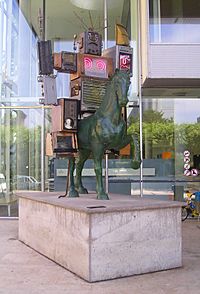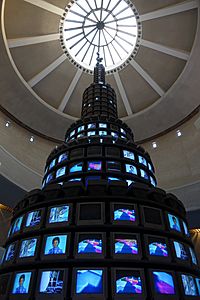Nam June Paik facts for kids
Quick facts for kids
Nam June Paik
|
|
|---|---|
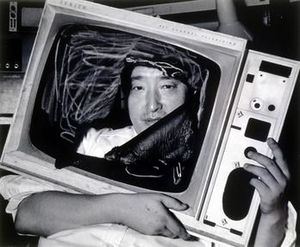
Nam June Paik in New York City, 1983.
|
|
| Born | July 20, 1932 |
| Died | January 29, 2006 (aged 73) |
| Nationality | Korean |
| Education | University of Tokyo, Ludwig Maximilian University of Munich |
| Known for | Video art, performance, installation art |
| Movement | Fluxus |
| Spouse(s) | |
| Awards | |
| Korean name | |
| Hangul | |
| Hanja | |
| Revised Romanization | Baek Namjun |
| McCune–Reischauer | Paek Namjun |
Nam June Paik (Korean: 백남준; July 20, 1932 – January 29, 2006) was a Korean American artist. He is known as the founder of video art. He was the first to use the phrase "electronic super highway" in 1974. This term described how telecommunications would work in the future.
Contents
Biography of a Video Art Pioneer
Nam June Paik was born in Seoul, Japanese Korea, in 1932. He was the youngest of five children. His father owned a large textile company. From a young age, Paik learned to play the classical piano. Because his family was wealthy, he received a top education in modern music.
In 1950, during the Korean War, Paik and his family left Korea. They first went to Hong Kong and then moved to Japan. Paik earned a degree in aesthetics from the University of Tokyo in 1956. He wrote his thesis on the composer Arnold Schoenberg.
In 1957, Paik moved to West Germany. He studied music history at Munich University. While there, he met famous composers like Karlheinz Stockhausen and John Cage. He also met conceptual artists like George Maciunas, Joseph Beuys, and Wolf Vostell.
Paik returned to Tokyo in 1961 to learn about new technologies. Between 1962 and 1963, he got a Sony Port-a-Pak. This was the first video recorder available to buy. He was good friends with Nobuyuki Idei, a top executive at Sony.
From 1962, Paik was part of an experimental art group called Fluxus.
In 1964, Paik moved to the United States of America and lived in New York City. He started working with cellist Charlotte Moorman. They combined his video, music, and performance ideas. From 1979 to 1996, Paik was a professor at the Kunstakademie Düsseldorf.
After almost 35 years, Paik returned to South Korea on June 22, 1984. From the mid-1980s to the mid-1990s, Paik was very important in Korea's art world. He helped open Korea's art scene to the rest of the world. He had solo shows in Korea. He also created two worldwide TV projects for the 1986 Asia Games and the 1988 Olympics in Seoul.
Paik also organized many art shows in Korea. Some shows introduced artists like John Cage and Joseph Beuys to Korea. Others brought new video art ideas from Europe and the U.S. to Korea. Paik helped bring the 1993 Whitney Biennial to Seoul. He also helped start the Gwangju Biennale and the Korea Pavilion at the Venice Biennale.
Paik's journey across different countries shaped his art and identity. He lived in Korea, Japan, Germany, and the U.S. This global experience influenced his artworks. For example, his piece Guadalcanal Requiem (1977) reminds people of World War II in the Pacific. Even as he became famous worldwide, Paik always remembered his Korean roots.
Famous Artworks and Ideas
Nam June Paik joined the Neo-Dada art movement called Fluxus. This group was inspired by composer John Cage. Cage used everyday sounds in his music. Paik's first big show was in 1963. It was called Exposition of Music-Electronic Television. He placed televisions everywhere and used magnets to change their pictures. In 1960, during a piano show in Cologne, he played Chopin. Then he jumped on the piano and went into the audience.
John Cage suggested Paik learn about Zen Buddhism. Paik already knew about Buddhism from his childhood. But Cage's interest made Paik look at his own background again.
In 1963 and 1964, engineers Hideo Uchida and Shuya Abe taught Paik how to change TV signals. This led to the Abe-Paik video synthesizer. This was a key tool for his future TV art.
In 1965, Paik got a Sony TCV-2010. This was the first video-tape recorder for regular people. Paik used it to record TV shows. He often changed the broadcasts and the magnetic tape. In 1967, Sony made the first portable video recorder, the Sony Portapak. It had a battery and a handheld camera. With this, Paik could record things anywhere. He became famous for his creative and fun art.
In 1971, Paik and Charlotte Moorman made TV Cello. This was a cello made from three television sets stacked up. It also had cello strings. When Moorman played it, images of her and other cellists appeared on the screens. They made another TV Cello in 1976 in Australia.
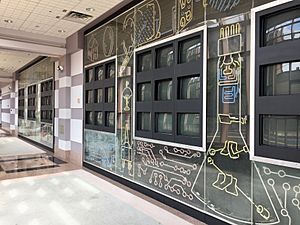
In 1974, Nam June Paik used the term "super highway" for telecommunications. Many people think he created the phrase "Information Superhighway".
In the 1970s, Paik imagined a global group of viewers. He called it a Video Common Market. It would share videos freely. In 1978, Paik worked with Dimitri Devyatkin. They made Media Shuttle: New York-Moscow for WNET. It compared life in New York and Moscow. This video is now in museums worldwide.
Perhaps Paik's most famous work is TV Buddha. It shows a Buddha statue watching itself live on a TV screen. Paik made many versions of this work. The first one was from 1974.
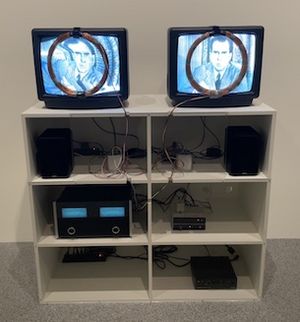
Another piece, Positive Egg, shows a white egg on a black background. On a series of monitors, the egg gets bigger and bigger. Eventually, it becomes an abstract shape. In Video Fish (1975), aquariums with live fish are placed in front of TVs. The TVs show videos of other fish.
In 1993, Paik created an artwork for the NJN Building in Trenton, New Jersey. This art uses neon lights and video screens. It is currently not working, but there are plans to fix it.
On January 1, 1984, Paik aired Good Morning, Mr. Orwell. This was a live TV link between WNET New York, Centre Pompidou Paris, and South Korea. Artists like John Cage and Salvador Dalí took part. Paik wanted to show that George Orwell's idea of "Big Brother" had not come true.
After returning to Korea in 1984, Nam June Paik explored ideas of global connections with Asia. He looked at concepts like the Silk Road. He also led projects that used his connections with businesses and the government in South Korea. Bye Bye Bye Kipling showed this new phase in Paik's art. It was broadcast during the Asia Games in Seoul. The title referred to a poem by Rudyard Kipling. The poem said "East is East, and West is West, and never the twain shall meet." But Paik's work brought together artists like Keith Haring and designer Issey Miyake. Bye Bye Kipling also helped Korea's goal of sharing its culture worldwide. It showed shaman rituals and Korean drum dancers alongside Seoul's "economic miracle" and the busy Namdaemun Market.
Two years later, in 1988, Paik installed The More the Better. It is in the National Museum of Modern and Contemporary Art, Gwacheon. This giant tower has 1003 monitors. This number refers to October 3, the day Korea was founded by Dangun. The More the Better was featured in Paik's 1988 broadcast Wrap Around the World. This show was made for the Seoul Olympics.
For the German pavilion at the 1993 Venice Biennale, Paik made robot sculptures of historical figures. These included Catherine the Great and Dangun. He wanted to show the links between Europe and Asia.
Paik's 1995 artwork Electronic Superhighway: Continental U.S., Alaska, Hawaii is always on display. You can see it at the Lincoln Gallery of the Smithsonian American Art Museum.
Paik was famous for making robots out of television sets. He used wire and metal pieces. Later, he used parts from radios and TVs.
Even after having a stroke in 1996, he kept creating. In 2000, he made a satellite broadcast called Tiger is Alive. In 2004, he designed Global Groove 2004. This was an installation of monitors and video projections for the Deutsche Guggenheim in Berlin.
Exhibitions of His Work
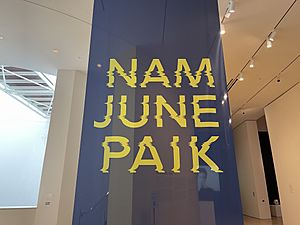
Paik's first exhibition was in 1963 in Wuppertal, Germany. It was called "Exposition of Music - Electronic Television". A large show of Paik's work was held at the Whitney Museum of American Art in 1982. Other major shows were held in Cologne (1976), Paris (1978), San Francisco (1989), and Basel (1991).
Nam June Paik’s first big show in Korea was Video Time - Video Space. It opened on July 30, 1992, at the National Museum of Modern and Contemporary Art, Korea. Even though it lasted only 34 days, almost 118,000 people paid to see it. The show had about 150 artworks. Paik chose artworks that connected with Korean culture and history. The exhibition also showed works from his TV Buddha series.
A final big show of his work was in 2000 at the Guggenheim Museum in New York. He created a special artwork for the museum called Modulation in Sync (2000). This show happened at the same time as a gallery show of his wife's work. Her art was about his recovery from a stroke in 1996.
In 2011, an exhibition focused on Paik's video sculpture One Candle, Candle Projection (1988-2000). It opened at the National Gallery of Art in Washington, D.C. Another show was at the Smithsonian American Art Museum in Washington, D.C., from 2012 to 2013.
Paik's art was also in important group shows. These included the São Paulo Biennale (1975), Whitney Biennial (many times), Documenta (1977 and 1987), and Venice Biennale (1984 and 1993).
From April to September 2015, Paik's works T.V. Clock, 9/23/69: Experiment with David Atwood, and ETUDE1 were shown. They were part of "Watch This! Revelations in Media Art" at the Smithsonian American Art Museum.
In 2019, the Tate Modern had an exhibition about Paik as a collaborator. This show later went to the San Francisco Museum of Modern Art. It was the first big show of Paik's work on the West Coast.
Where to See His Art (Collections)
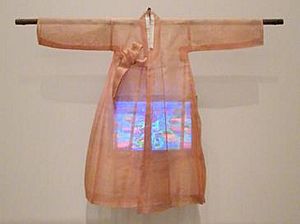
Many public museums have Nam June Paik's art. Some of these include:
- The Detroit Institute of Arts
- The National Museum of Modern and Contemporary Art (Korea)
- Leeum, Samsung Museum of Art (Seoul)
- The Nam June Paik Art Center (Korea)
- The Hirshhorn Museum and Sculpture Garden (Washington D.C.)
- The Honolulu Museum of Art
- The Musée d'Art Moderne de la Ville de Paris
- The National Gallery of Australia (Canberra)
- The Smithsonian American Art Museum (Washington D.C.)
- The Walker Art Center (Minneapolis, Minnesota)
- The Rose Goldsen Archive of New Media Art, Cornell University Library (New York)
Awards and Honors
- 1991: Goslarer Kaiserring
- 1992: Picasso Medal
- 1993: Golden Lion, Venice Biennale
- 1995: Ho-Am Prize in the Arts
- 1998: Kyoto Prize in Arts and Philosophy
- 2000: Order of Cultural Merit (Korea)
- 2001: Wilhelm Lehmbruck Prize
- 2001: Lifetime Achievement in Contemporary Sculpture Award
- 2004: Edward MacDowell Medal in the Arts
His Archive and Legacy
Nam June Paik's art often used old technology. This makes it hard to keep his works in good condition. In 2006, Paik's family asked museums how they would care for his archive. The Smithsonian American Art Museum was chosen.
The archive holds many things. It has Paik's early writings on art and technology. It also has letters with other artists like Charlotte Moorman and John Cage. There is a full collection of videotapes he used. It also includes notes, sketches, notebooks, and plans for his videos. The archive also has old TVs, video projectors, radios, cameras, and musical instruments.
Curator John Hanhardt, a friend of Paik, said the archive was "like a huge memory machine." He described it in the book Nam June Paik: Global Visionary.
Michael Mansfield, a curator at the Smithsonian American Art Museum, helped set up Paik's art. He managed hundreds of old TV sets and all their wires. He even made an app to control the electronic artworks.
Many of Paik's early works and writings are in a book called Nam June Paik: Videa 'n' Videology 1959–1973.
His Influence on Art
Nam June Paik was a pioneer of video art. His ideas had a big impact on art in the late 20th century. He continues to inspire new artists today. Some artists influenced by Paik include Christian Marclay and Cory Arcangel.
Paik's work was first shown in Korea on March 20, 1974. The artist Park Hyunki saw Paik's Global Groove at this screening. It inspired Park Hyunki to start making video art himself.
Personal Life and Passing
Paik moved to New York in 1964. In 1977, he married the video artist Shigeko Kubota.
In 1996, Paik had a stroke. This made his left side paralyzed. He used a wheelchair for the last ten years of his life, though he could walk with help. He passed away on January 29, 2006, in Miami, Florida. He died from problems related to his stroke. He was survived by his wife, a brother, and his nephew, Ken Paik Hakuta. Ken Hakuta is an inventor and TV personality. He managed Paik's art studio in New York.
One of his grandsons is Jinu. Jinu is a South Korean rapper and singer. He is part of the hip-hop duo Jinusean.
See also
 In Spanish: Nam June Paik para niños
In Spanish: Nam June Paik para niños
- Video sculpture


